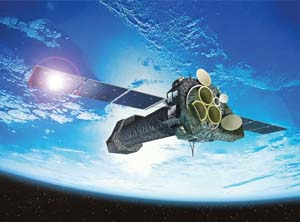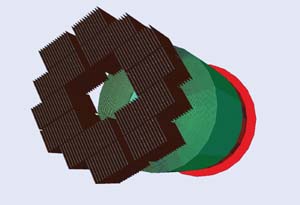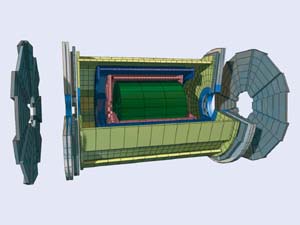Geant4 is a showcase example of technology transfer from particle physics to other fields such as space and medical science, argue Maria Grazia Pia and Jürgen Knobloch.

Simulation programs play a fundamental role in optimizing the design of particle physics experiments. In the development of reconstruction programs, they provide the necessary input in the form of simulated raw data. In the analysis process they are required to understand the systematic effects resulting from detector resolution and acceptance, as well as the influence of background processes. The predecessors of the Geant4 toolkit – which were written in the now almost obsolete Fortran language – were successfully used at CERN for experiments at the laboratory’s Large Electron-Positron collider and for the design of experiments for the Large Hadron Collider (LHC).
Geant4 was launched as an R&D project in 1994 to demonstrate the suitability of object-oriented programming technology for large software projects in particle physics. The initial collaboration of members of particle physics institutes around the world has since been joined by scientists from the European Space Agency (ESA) and members of the medical community.
The Geant4 software toolkit was designed to simulate particle interactions with matter for particle physics. It contains components to model in detail the geometry and materials of complex particle detectors. The simulated particles are propagated through magnetic and electrical fields and through the materials of the detectors. The core of the program contains information on numerous physics processes that govern the interactions of particles across a wide energy range. Visualization tools and a flexible user interface are available as separate components. Rigorous software engineering makes Geant4 open to change in a rapidly evolving software environment, while at the same time ensuring that it can be easily and fully maintained over the lifetime of large-scale experiments.
Accurate simulations
Geant4 was publicly released in December 1998 and has since been further developed. All Geant4 code and documentation is openly available via the Web. At a recent conference on calorimetry in particle physics at the California Institute of Technology, US, the quality of Geant4’s simulation of the response of electromagnetic and hadronic showers in calorimeters was demonstrated in comparisons of test-beam data with simulation. One of the speakers for the ATLAS experiment (currently in preparation for the LHC) concluded that Geant4 is mature enough as a toolkit, with sufficient physics for electromagnetic showers implemented, to be considered for large-scale detectors.
Other speakers reported on the first results of ongoing comparison projects of hadronic interactions in calorimeters. These first results look very promising. In fact, Geant4 is used in production for the BaBar experiment at the Stanford Linear Accelerator Center, US, and more than 300 million events have been simulated already. This, together with the fact that Geant4 applications are as fast as similar Fortran-based applications, shows that object-oriented technology is capable of standing up to the challenge.
Simulation is equally important in space-based astroparticle physics. Most space probes need to be able to operate for many years without the possibility of physical repair after launch. It is therefore essential to be able to predict the behaviour of all components in the space environment, and in particular to judge the likely effect of radiation on on-board electronics and detectors. The availability of the ISO standard for the exchange of product data (STEP) interface in Geant4 is especially advantageous, as the use of professional computer-aided design tools is commonplace in the aerospace industry.
Geant4 was first used for space applications by ESA in 1999, when ESA and the US National Aeronautics and Space Administration (NASA) each launched an X-ray telescope. Both telescopes follow highly eccentric orbits, reaching at their far point one-third of the distance to the Moon. NASA’s Chandra was launched in July 1999. During the initial phase of operation, some of the front-illuminated charge-coupled devices (CCDs) experienced an unexpected degradation in charge-transfer efficiency. ESA scientists, who had been planning to launch their X-ray multi-mirror (XMM) Newton Observatory in December 1999, needed to understand the possible origin of this problem to protect their detectors from similar damage.

The geometries of both telescopes, including the concentric mirror systems, were described using the Geant4 toolkit. Particles, in particular low-energy protons trapped by the Earth’s magnetosphere in the Van Allen radiation belts, were simulated entering the apertures of the telescopes. The simulation revealed that these particles are scattered at shallow angles from the mirror surfaces and are focused onto the surface of the sensitive CCD detectors, completely bypassing the collimators and other elements that were supposed to shield the devices.

This simulation explained why NASA’s emergency measure to move the detectors out of the focal plane during the passage of the radiation belt prevented any further degradation. With the Geant4 study’s input, the operational procedures of XMM Newton were arranged so that the detectors were powered off during the passage of the radiation belts for about 8 h of the 48 h orbit. Both telescopes now deliver magnificent scientific data.
The dose estimation by simulation of the International Space Station (ISS) radiation environment project (known as DESIRE) aims to use Geant4 to calculate radiation levels inside the Columbus ISS module and to estimate the radiation doses on the astronauts. Apart from assessing the risk involved in space missions from exposure to radiation, Geant4 plays an important role in evaluating the performance of particle detectors. For the ESA BepiColombo mission to Mercury, currently planned for launch in 2009, detectors will analyse the spectrum of fluorescence from planetary material induced by solar flares. Using Geant4, the spectra and expected detector response have been simulated and the optimization of the detector technology in the severe radiation environment close to the Sun is under way.
Medical applications
Geant4’s extended set of physics models, which handle both electromagnetic and hadronic interactions, can be used to address a range of medical applications from conventional photon-beam radiotherapy to brachytherapy (using radioactive sources), hadron therapy and boron neutron capture therapy. The tools for describing geometries, materials and electromagnetic fields can precisely model diverse real-life configurations. An interface to the Digital Imaging and Communications in Medicine (DICOM) standard will soon make it possible to import computer tomograph images directly into a Geant4 geometrical model. The quality-assurance methods applied in Geant4, its open-source distribution and its independent validation by a worldwide user community are particularly important in the medical domain.
Geant4 can play a significant role in estimating the accuracy of radiotherapy treatment planning, exemplified by comparisons of its simulations with commercial software and experimental data. One study exploited Geant4’s accurate simulation of electromagnetic interactions down to very low energies to account precisely for effects resulting from source anisotropy. The same method has also been applied to calculate dose distribution for certain superficial brachytherapy applicators where no other treatment-planning software is available.

Other studies have exploited Geant4’s capability for precision-modelling of geometries, materials and physics processes to provide accurate dose distributions in heterogeneous geometries. High-precision dose evaluation is important because, in some tumour sites, a 5% under-dosage would decrease local tumour-control probability from around 75% to 50%. As with typical physics applications, in which simulation is used to optimize the design of particle detectors, Geant4 has allowed the optimization of brachytherapy seeds, improving the treatment’s effectiveness while sparing surrounding healthy tissue. The suitability of Geant4 has been demonstrated in advanced radiotherapy techniques, such as intra-operatory and intensity-modulated radiotherapy. Several projects also apply Geant4 in the domain of radiodiagnostics. Possible future extensions include modelling the effects of radiation at the biomolecular level.
Geant4 is developed and maintained by an international collaboration of physicists and computer scientists. The open and collaborative relationship between the development team and its user communities has led to a two-way transfer of technology, with users from fields other than particle physics actively contributing. The expertise of the biomedical and space user communities in simulation has resulted in many significant contributions to Geant4 in areas such as testing and validation, as well as extensions of functionality. These developments bring valuable enhancements to Geant4’s applications in particle physics.








